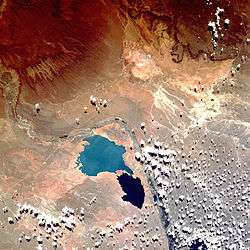Neuquén Group

To the lower left of the lake, a swath of light yellowish sandstones of the group's Huincul Formation are visible.
The Neuquén Group is a group of geologic formations found in Argentina. Rocks in the Neuquén Group fall within the Cenomanian to early Campanian stages of the Late Cretaceous Period, about 100 million to 80 million years in age. It overlies the older Lohan Cura Formation and is itself overlain by the younger Allen Formation of the Malargüe Group, separated from both by unconformities.
Deposits have been located in the provinces of Río Negro, Neuquén, and Mendoza. Although several different types of environments are represented in various sections of the Neuquén Group, the dominant regime is alluvial deposition. Many dinosaurs and other fossils have been discovered in these sediments.
There are seven formations within the Neuquén Group. These are divided into three subgroups named after major rivers in the area. In some works, the subgroups themselves are treated as formations and what usually is considered to be the formations as mere members of these. However, particularly in the Río Limay Subgroup, the formations are clearly composed of very distinct rocks.[1]
Neuquén Group strata, ordered from youngest to oldest
- Río Colorado Subgroup (Santonian to early Campanian)
- Anacleto Formation (early Campanian)
- Bajo de la Carpa Formation (Santonian)
- Río Neuquén Subgroup (late Turonian to Coniacian)
- Plottier Formation (late Coniacian ?to early Santonian)
- Portezuelo Formation (late Turonian to early Coniacian)
- Río Limay Subgroup (Cenomanian to early Turonian)
- Cerro Lisandro Formation (late Cenomanian to early Turonian)
- Huincul Formation (late Cenomanian)
- Candeleros Formation (early Cenomanian)
South of Añelo, taking the road between Lake Los Barreales and the Neuquén River will provide splendid views on the successively younger formations, starting with the Cerro Lisandro Formation to the lake's northwest, and finally crossing the Anacleto Formation about 35 km down the road near the lake's eastern tip. The older strata are exposed south of Lake Los Barreales.[1]
See also
Footnotes
References
- Leanza, H.A.; Apesteguia, S.; Novas, F.E. & de la Fuente, M.S. (2004): Cretaceous terrestrial beds from the Neuquén Basin (Argentina) and their tetrapod assemblages. Cretaceous Research 25(1): 61-87. doi:10.1016/j.cretres.2003.10.005 (HTML abstract)
- Sánchez, Maria Lidia; Heredia, Susana & Calvo, Jorge O. CALVO (2006): Paleoambientes sedimentarios del Cretácico Superior de la Formación Plottier (Grupo Neuquén), Departamento Confluencia, Neuquén [Sedimentary paleoenvironments in the Upper Cretaceous Plottier Formation (Neuquen Group), Confluencia, Neuquén.]. Revista de la Asociación Geológica Argentina 61(1): 3-18. PDF fulltext